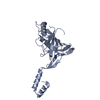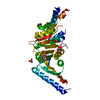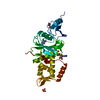[English] 日本語
 Yorodumi
Yorodumi- PDB-1shc: SHC PTB DOMAIN COMPLEXED WITH A TRKA RECEPTOR PHOSPHOPEPTIDE, NMR... -
+ Open data
Open data
- Basic information
Basic information
| Entry | Database: PDB / ID: 1shc | ||||||
|---|---|---|---|---|---|---|---|
| Title | SHC PTB DOMAIN COMPLEXED WITH A TRKA RECEPTOR PHOSPHOPEPTIDE, NMR, MINIMIZED AVERAGE STRUCTURE | ||||||
 Components Components |
| ||||||
 Keywords Keywords | COMPLEX (SIGNAL TRANSDUCTION/PEPTIDE) / COMPLEX (SIGNAL TRANSDUCTION-PEPTIDE) / PHOSPHOTYROSINE BINDING DOMAIN (PTB) / COMPLEX (SIGNAL TRANSDUCTION-PEPTIDE) complex | ||||||
| Function / homology |  Function and homology information Function and homology informationregulation of superoxide metabolic process / positive regulation of cell proliferation in bone marrow / neurotrophin p75 receptor binding / behavioral response to formalin induced pain / olfactory nerve development / TRKA activation by NGF / PLC-gamma1 signalling / Signalling to STAT3 / programmed cell death involved in cell development / response to hydrostatic pressure ...regulation of superoxide metabolic process / positive regulation of cell proliferation in bone marrow / neurotrophin p75 receptor binding / behavioral response to formalin induced pain / olfactory nerve development / TRKA activation by NGF / PLC-gamma1 signalling / Signalling to STAT3 / programmed cell death involved in cell development / response to hydrostatic pressure / neurotrophin receptor activity / mechanoreceptor differentiation / nerve growth factor receptor activity / neurotrophin binding / GPI-linked ephrin receptor activity / nerve growth factor signaling pathway / axonogenesis involved in innervation / nerve growth factor binding / Sertoli cell development / Retrograde neurotrophin signalling / sympathetic nervous system development / XBP1(S) activates chaperone genes / NGF-independant TRKA activation / Signalling to p38 via RIT and RIN / neurotrophin TRKA receptor binding / ARMS-mediated activation / transmembrane receptor protein tyrosine kinase adaptor activity / Interleukin-15 signaling / Interleukin-2 signaling / positive regulation of programmed cell death / positive regulation of Ras protein signal transduction / Signaling by LTK / positive regulation of synapse assembly / PI3K/AKT activation / epidermal growth factor receptor binding / Shc-EGFR complex / peptidyl-tyrosine autophosphorylation / epidermal growth factor binding / Signaling by ALK / Frs2-mediated activation / neurotrophin TRK receptor signaling pathway / detection of temperature stimulus involved in sensory perception of pain / RET signaling / Interleukin-3, Interleukin-5 and GM-CSF signaling / positive regulation of GTPase activity / response to electrical stimulus / Activated NTRK3 signals through RAS / Activated NTRK2 signals through RAS / Role of LAT2/NTAL/LAB on calcium mobilization / SHC1 events in ERBB4 signaling / Interleukin receptor SHC signaling / Signalling to RAS / Signal attenuation / detection of mechanical stimulus involved in sensory perception of pain / neuron development / positive regulation of synaptic transmission, glutamatergic / SHC-related events triggered by IGF1R / response to axon injury / SHC-mediated cascade:FGFR3 / MET activates RAS signaling / SHC-mediated cascade:FGFR2 / SHC-mediated cascade:FGFR4 / Erythropoietin activates RAS / SHC-mediated cascade:FGFR1 / ephrin receptor binding / Signaling by CSF3 (G-CSF) / insulin-like growth factor receptor binding / Tie2 Signaling / phosphotyrosine residue binding / Integrin signaling / transmembrane receptor protein tyrosine kinase activity / SHC1 events in EGFR signaling / FCERI mediated Ca+2 mobilization / insulin-like growth factor receptor signaling pathway / Insulin receptor signalling cascade / SHC1 events in ERBB2 signaling / axon guidance / cell surface receptor protein tyrosine kinase signaling pathway / peptidyl-tyrosine phosphorylation / Constitutive Signaling by Overexpressed ERBB2 / negative regulation of angiogenesis / B cell differentiation / insulin receptor binding / FCERI mediated MAPK activation / response to nutrient levels / Signaling by ERBB2 TMD/JMD mutants / positive regulation of NF-kappaB transcription factor activity / Constitutive Signaling by EGFRvIII / cell-cell adhesion / positive regulation of neuron projection development / circadian rhythm / receptor protein-tyrosine kinase / cellular response to nerve growth factor stimulus / Signaling by ERBB2 ECD mutants / receptor tyrosine kinase binding / Signaling by ERBB2 KD Mutants / phospholipid binding / cellular response to growth factor stimulus / cellular response to nicotine / kinase binding Similarity search - Function | ||||||
| Biological species |  Homo sapiens (human) Homo sapiens (human) | ||||||
| Method | SOLUTION NMR | ||||||
 Authors Authors | Zhou, M.-M. / Ravichandran, K.S. / Olejniczak, E.T. / Petros, A.M. / Meadows, R.P. / Sattler, M. / Harlan, J.E. / Wade, W.S. / Burakoff, S.J. / Fesik, S.W. | ||||||
 Citation Citation |  Journal: Nature / Year: 1995 Journal: Nature / Year: 1995Title: Structure and ligand recognition of the phosphotyrosine binding domain of Shc. Authors: Zhou, M.M. / Ravichandran, K.S. / Olejniczak, E.F. / Petros, A.M. / Meadows, R.P. / Sattler, M. / Harlan, J.E. / Wade, W.S. / Burakoff, S.J. / Fesik, S.W. #1:  Journal: Nat.Struct.Biol. / Year: 1996 Journal: Nat.Struct.Biol. / Year: 1996Title: Structural Basis for Il-4 Receptor Phosphopeptide Recognition by the Irs-1 Ptb Domain Authors: Zhou, M.M. / Huang, B. / Olejniczak, E.T. / Meadows, R.P. / Shuker, S.B. / Miyazaki, M. / Trub, T. / Shoelson, S.E. / Fesik, S.W. #2:  Journal: J.Biol.Chem. / Year: 1995 Journal: J.Biol.Chem. / Year: 1995Title: Specificity of the Ptb Domain of Shc for Beta Turn-Forming Pentapeptide Motifs Amino-Terminal to Phosphotyrosine Authors: Trub, T. / Choi, W.E. / Wolf, G. / Ottinger, E. / Chen, Y. / Weiss, M. / Shoelson, S.E. #3:  Journal: Science / Year: 1994 Journal: Science / Year: 1994Title: An Alternative to Sh2 Domains for Binding Tyrosine-Phosphorylated Proteins Authors: Kavanaugh, W.M. / Williams, L.T. | ||||||
| History |
|
- Structure visualization
Structure visualization
| Structure viewer | Molecule:  Molmil Molmil Jmol/JSmol Jmol/JSmol |
|---|
- Downloads & links
Downloads & links
- Download
Download
| PDBx/mmCIF format |  1shc.cif.gz 1shc.cif.gz | 84.7 KB | Display |  PDBx/mmCIF format PDBx/mmCIF format |
|---|---|---|---|---|
| PDB format |  pdb1shc.ent.gz pdb1shc.ent.gz | 63.7 KB | Display |  PDB format PDB format |
| PDBx/mmJSON format |  1shc.json.gz 1shc.json.gz | Tree view |  PDBx/mmJSON format PDBx/mmJSON format | |
| Others |  Other downloads Other downloads |
-Validation report
| Summary document |  1shc_validation.pdf.gz 1shc_validation.pdf.gz | 261.6 KB | Display |  wwPDB validaton report wwPDB validaton report |
|---|---|---|---|---|
| Full document |  1shc_full_validation.pdf.gz 1shc_full_validation.pdf.gz | 261.4 KB | Display | |
| Data in XML |  1shc_validation.xml.gz 1shc_validation.xml.gz | 7.5 KB | Display | |
| Data in CIF |  1shc_validation.cif.gz 1shc_validation.cif.gz | 9.6 KB | Display | |
| Arichive directory |  https://data.pdbj.org/pub/pdb/validation_reports/sh/1shc https://data.pdbj.org/pub/pdb/validation_reports/sh/1shc ftp://data.pdbj.org/pub/pdb/validation_reports/sh/1shc ftp://data.pdbj.org/pub/pdb/validation_reports/sh/1shc | HTTPS FTP |
-Related structure data
| Similar structure data |
|---|
- Links
Links
- Assembly
Assembly
| Deposited unit | 
| |||||||||
|---|---|---|---|---|---|---|---|---|---|---|
| 1 |
| |||||||||
| NMR ensembles |
|
- Components
Components
| #1: Protein | Mass: 21409.584 Da / Num. of mol.: 1 / Fragment: PTB DOMAIN Source method: isolated from a genetically manipulated source Source: (gene. exp.)  Homo sapiens (human) / Strain: BL21 (DE3) / Cell line: BL21 / Gene: PTB DOMAIN OF SHC / Plasmid: PET15B / Gene (production host): PTB DOMAIN OF SHC / Production host: Homo sapiens (human) / Strain: BL21 (DE3) / Cell line: BL21 / Gene: PTB DOMAIN OF SHC / Plasmid: PET15B / Gene (production host): PTB DOMAIN OF SHC / Production host:  |
|---|---|
| #2: Protein/peptide | Mass: 1514.508 Da / Num. of mol.: 1 Source method: isolated from a genetically manipulated source References: UniProt: P04629 |
| Has protein modification | Y |
-Experimental details
-Experiment
| Experiment | Method: SOLUTION NMR |
|---|
- Sample preparation
Sample preparation
| Crystal grow | *PLUS Method: other / Details: NMR |
|---|
- Processing
Processing
| Software |
| ||||||||
|---|---|---|---|---|---|---|---|---|---|
| NMR software | Name:  X-PLOR / Developer: BRUNGER / Classification: refinement X-PLOR / Developer: BRUNGER / Classification: refinement | ||||||||
| Refinement | Software ordinal: 1 Details: SET OF IDEAL BOND LENGTHS AND ANGLES WERE USED DURING REFINEMENT: PARALLHDG.PRO IN X-PLOR. | ||||||||
| NMR ensemble | Conformers submitted total number: 1 |
 Movie
Movie Controller
Controller










 PDBj
PDBj
























